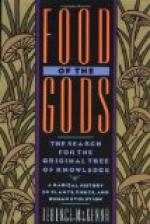[Illustration—Black and White Plate: White’s Club, on left of St. James’s Palace. (From a Drawing of the time of Queen Anne.)]
A little later the “Indian Nectar,” recommended by a learned doctor on account of “its secret virtue,” was to be obtained of “an honest though poor man” in East Smithfield at 6s. 8d. a pound, or the “commoner sort at about half the price,” so that it was getting within more general reach. Subsequently the following advertisement appeared regarding a patented preparation of cocoa “now sold at 4s. 9d. per pound.”
“N.B.—The curious may be supplied with this superfine chocolate, that exceeds the finest sold by other makers, plain at 6s., with vanillos at 7s. To be sold for ready money only at Mr. Churchman’s Chocolate Warehouse, at Mr. John Young’s, in St. Paul’s Churchyard, London, A.D. 1732.”
The opportunities of increasing the revenue from the growing favourite were not lost sight of, and till 1820 its spread was checked by a duty of 1s. 6d. a pound, collected by the sale of stamped wrappers for each pound, half-pound, or quarter-pound, “neither more nor less,” just as in the case of patent medicines at present.
In the reign of George III. the duty on colonial cocoa was raised to 1s. 10d. a pound, that on such as the East India Company imported to 2s., and that on all other sources of supply to 3s. In the early years of the last century the cocoa imported from any country not a British possession was charged no less than 5s. 10d. a pound as excise, with an extra Custom’s duty of from 2 1/2d. to 4 3/4d. on entry for home consumption. This restrictive tariff was by degrees relaxed, but it is only since 1853 that the duty has been reduced to 2d. a pound on the manufactured article, or 1d. a pound on the raw material.
While the heavy duties were in force, all houses in which the manufacture or sale of cocoa was carried on were compelled to have the fact stated over their doors, under penalty of L200 from the dealer having more than six pounds in his possession (who had to be licensed), and L100 from the customer encouraging the illicit trade. No less than L500 as fine and twelve months in the county gaol were inflicted for counterfeiting the stamp or selling chocolate without a stamp. To prevent evasion by selling the drink ready made, it was enacted under George I., whose physicians were extolling its medicinal virtues, that




